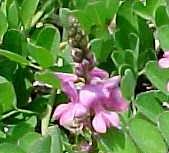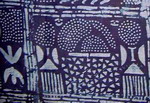 Fashion Jeans Asia, Spotlight on Jeans FashionHistory of Traditional Indigo Dyeing, indigo can be traced back 7000 years | |||
| Jeans Home - Buying Jeans Online -Take Care Jeans - Select Jeans - Indigo History - Jeans, Why? - Perfume - Other Styles | |||
| INDIGO, Page 1, Page 2, Page 3, Page 4 | |||

Today, synthetic indigo used to dye blue jeans has almost totally replaced natural dye in most societies. This is because synthetic indigo is cheaper to produce and more uniform in concentration than natural indigo. Natural indigo tends to be used today primarily by artists and craftsmen producing specialty products, and by those dyers involved in textile conservation or historical recreation. They are also used on ceremonial occasions, notably wed dings and funerals, and in traditional medicine. These days some add a few crystals of synthetic indigo to the final dye in order to darken the hue.  Indigo dyeing using the plant species Lonchocarpus cyanescens or Indigofera suffruticosa, or other Lonchocarpus and Indigoferra species, such as I. tinctoria and I. arrecta (all of which grow wild), were the most common and popular sources of color throughout West Africa. Both Anglophone and Francophone countries were quite active in this indigenous technology; e.g., Mali, Nigeria, Senegal, Guinea, Gambia, Liberia, and Ivory Coast. Research on excavations from caves in Mali has shown that the indigo dyed cotton garments dated between the 11th and the 16th centuries, indicating that by the 11th century weaving and indigo dyeing had already reached a high standard in West Africa. Many of the tie. dye de signs found are similar to those still in use today. Indigo dyeing using the plant species Lonchocarpus cyanescens or Indigofera suffruticosa, or other Lonchocarpus and Indigoferra species, such as I. tinctoria and I. arrecta (all of which grow wild), were the most common and popular sources of color throughout West Africa. Both Anglophone and Francophone countries were quite active in this indigenous technology; e.g., Mali, Nigeria, Senegal, Guinea, Gambia, Liberia, and Ivory Coast. Research on excavations from caves in Mali has shown that the indigo dyed cotton garments dated between the 11th and the 16th centuries, indicating that by the 11th century weaving and indigo dyeing had already reached a high standard in West Africa. Many of the tie. dye de signs found are similar to those still in use today.Though the process is quite arduous, it provided a rich color usually missing in synthetically dyed fabric. The basic methods of dye production are quite similar throughout the West Coast of Africa with some variation. In the present study, however, the process of indigo dyeing was investigated, since only scattered information is available on this intricate and rap idly dying art in Sierra Leone. ORIGIN OF INDIGO DYEING IN SIERRA LEONE  The art of tie and dye using natural dyes is believed to have been practiced in almost every country in the world, including African countries. It is thought that the Madingoes and the Susus who migrated from Guinea between 1820 and 1920 and settled in the North and Northwest of Sierra Leone especially in Makeni, the capital of the Northern Province of Sierra Leone, brought the art of “gara” dyeing with them. This is partly the reason for the concentration of the trade in this part of the country. The art of tie and dye using natural dyes is believed to have been practiced in almost every country in the world, including African countries. It is thought that the Madingoes and the Susus who migrated from Guinea between 1820 and 1920 and settled in the North and Northwest of Sierra Leone especially in Makeni, the capital of the Northern Province of Sierra Leone, brought the art of “gara” dyeing with them. This is partly the reason for the concentration of the trade in this part of the country.The word “gara” is derived from the term “gareh,” which is the Kuranko (a local language) word for the leguminous plant, indigo; i.e., Indigoferra saffruticosa or Lonchocaipus cyanescens, weedy climbers growing to about 10-15 feet in height. It is from the leaves of this plant that the indigo dye is obtained and used to dye cloth. This plant is ubiquitous in Sierra Leone especially in the Northern Province. “Gara” is also used more broadly to include any cloth dyed with the natural indigo dye, other natural dyes, or even with im ported synthetic dyes. Thus, the plant and the leaves from which the native dye is obtained, the dyed cloths, and the clothes are all known as “gara.” |
|||
| INDIGO, Page 1, Page 2, Page 3, Page 4 | |||
| Copyright Jeans and Denim - Jeans Manufacturer 2008 (c) | |||
